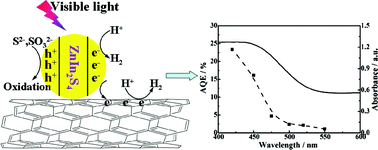Multiwalled carbon nanotubes (MWCNTs) and ZnIn2S4 composites were prepared by a facile hydrothermal method, which was used for hydrogen production under visible-light (λ ≥ 420 nm) irradiation. The obtained MWCNTs/ZnIn2S4 composites were characterized by X-ray diffraction (XRD), thermogravimetric and differential scanning calorimetry analyses (TG-DSC), field emission scanning electron microscopy (FESEM), high-resolution transmission electron microscopy (HRTEM), energy-dispersive X-ray spectroscopy (EDS), X-ray photoelectron spectroscopy (XPS), UV-vis diffuse reflectance absorption spectra (DRS), Fourier transform IR spectroscopy (FTIR) and Photoluminescence spectra (PL). It was found that the MWCNTs were embedded into the interior of floriated ZnIn2S4 microspheres. The effects of the composite ratio in the MWCNTs/ZnIn2S4 on the photocatalytic activity for hydrogen production were investigated. The results show that the 3 wt% MWCNTs/ZnIn2S4 composite reaches its maximum photocatalytic hydrogen production efficiency with an apparent quantum efficiency as high as 23.3% under 420 nm light irradiation. The significantly enhanced photoactivity for the present composite originates from the synergetic effect of its component intrinsic properties. A possible mechanism of the MWCNTs/ZnIn2S4 composite as a photocatalyst for H2 evolution was proposed.
